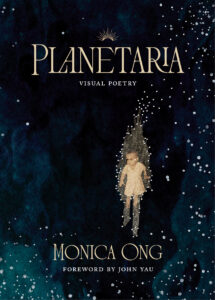 Review by Rebecca Jane
Review by Rebecca Jane
Planetaria re-charts the stars with the poetics of science. Monica Ong, a designer and experimental author, has invented a new genre that spins the literary, visual, and scientific arts to “map us from want to that jeweled inner sky” (11). This book is a fresh experience, like a wander through an art gallery in a newly discovered universe that has always been here. We can say this collection of poetry deals with themes of Asian diaspora, family, and science-based facts superimposed upon the human heart’s layered emotional cosmology. But the kinds of naming and categorization that we find in a book review are too limiting. This collection of image poems urges bold discovery and new ways of expression. So, instead, maybe it is more accurate to say this book is “The constant waking of the skin’s red crawl of ants” (16). This book’s genre might be described as “listening for my foremothers’ echoes in the afterlight” (17). Monica Ong, a United States Artist Fellow, is the author of Silent Anatomies, and her hybrid image poems and installations present hidden narratives of women and diaspora and have been featured at institutions such as the New York’s Center for Book Arts, Hunterdon Art Museum, and Poetry Foundation.
The hybrid poem-images in Planetaria, when read/viewed with slow, contemplative consideration, the super impositions and layers reveal family photos behind unified background color behind a map of the constellations behind graphs and numbers and measures. It’s an astronomy lesson, an perspective shift, and a play for perception. Meaning emerges, revealing a secret experience of family, tradition, words, images, and stars. This invites us to ask, what do our family constellations look like beneath and beyond? What colors might be bleeding through our lineages? Observing the world with a balance of scientific precision and emotional fluidity, the poet proclaims, “I am learning to / shape my / EMPTINESS / into an ear that can / shape the storm” (19).
Many lines challenge women to make bold moves and show themselves: “When will we / dragon king / daughters / no longer walk / this world / hiding our tails?” (22)
These hybrid studies in intergalactic imagery accompanied by female-centric perception inspire thinking outside of the box, beyond what we think we know about who we are and what it means to be human:
Imagine a woman’s calculations opening up the sky, the sun’s orbit but a mole on the lip of solar clustered nipple. How she spilled the milk from the glass of her astronomer eye knowing it would feed another hunger in another womb of time (32).
With its enormous perception, this book lends itself to be relished over and over; and, each time the reader will discover something new, see something in a new way, and open up to deeper realms of thinking and feeling within and beyond. If a poet could birth a star system on the page, that’s what Ong has done here. She’s accomplished what great art intends to do—art makes the world brand new.
It is rare that one reads a book, feels a visceral charge rush through the body, and feels lit with truth; but, this is what happens when one reads Planetaria. And when the poem “Diaspora Nova” asks, “when will you burst into that splendor of your miracle arrival?” one can’t help but answer, reading these poems, I feel as though that is what I have just done. Thank you!
Planetaria: Visual Poetry byMonica Ong
Proxima Vera, May, 2025, 90 pages, $40, paper
ISBN: 9798218510060
Rebecca Jane is the author of She Bleeds Sestinas, which was a finalist for a Best Book Award in 2023. She works as a freelance writer, ghostwriter, and poet who travels to Asia to study yoga, Sanskrit, and Mandarin. She lives with her daughters on unceded Kumeyaay land. (San Diego, California).
